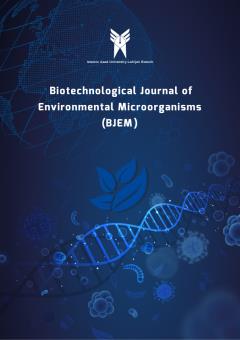نانوذرات اکسید روی-روتین: یک فرمولاسیون با پتانسیل جهت مهار بیوفیلم استافیلوکوکوس اورئوس
الموضوعات : Biotechnological Journal of Environmental Microorganisms
فاطمه عزیزی علیدوست
1
,
بهنام راستی
2
![]() ,
حجت اله زمانی
3
,
میرساسان میرپور
4
,
امیر میرزایی
5
,
حجت اله زمانی
3
,
میرساسان میرپور
4
,
امیر میرزایی
5
1 - گروه میکروبیولوژی، دانشکده علوم پایه، واحد لاهیجان، دانشگاه آزاد اسلامی، لاهیجان، گیلان، ایران
2 - گروه میکروبیولوژی، دانشکده علوم پایه، واحد لاهیجان، دانشگاه آزاد اسلامی، لاهیجان، گیلان، ایران
3 - گروه زیست شناسی، دانشگاه گیلان، رشت، ایران
4 - گروه میکروبیولوژی، دانشکده علوم پایه، واحد لاهیجان، دانشگاه آزاد اسلامی، لاهیجان، گیلان، ایران
5 - گروه زیست شناسی،واحد پرند، دانشگاه آزاد اسلامی، پرند، ایران
الکلمات المفتاحية: بیوفیلم, مقاومت دارویی, روتین, اکسید روی ,
ملخص المقالة :
استافیلوکوکوس اورئوس یک پاتوژن مهم در انسان است. این پاتوژن فرصت طلب مسئول انواع عفونت ها در انسان است. تشکیل بیوفیلم یک عامل کلیدی در توسعه عفونت و مقاومت دارویی است. بیوفیلم به عنوان یک مانع قرار گرفتن باکتری ها در معرض داروهای ضد باکتری را کاهش می دهد. هدف قرار دادن بیوفیلم باکتریایی یک استراتژی امیدوارکننده برای غلبه بر مقاومت دارویی است. در این کار، پتانسیل آنتی بیوفیلم نانوذرات اکسید روی-روتین مشخص شد. پتانسیل بازدارندگی رشد با استفاده از روش میکرورقیق سازی براث بررسی شد. اثرات بازدارندگی بیوفیلم نانوذرات اکسید روی و اکسید روی-روتین با رنگآمیزی کریستالی مورد بررسی قرار گرفت و از تصویربرداری میکروسکوپ الکترونی برای تجسم بیوفیلمهای تیمار شده و تیمار نشده استفاده شد. حداقل غلظت مهاری (MIC) نانوذرات اکسید روی و اکسید روی-روتین برای سویه های استافیلوکوکوس اورئوس 0.5-1.0 میکروگرم بر میلی لیتر بود. تیمار استافیلوکوکوس اورئوس با نانوذرات اکسید روی و اکسید روی-روتین به ترتیب 2/68 و 2/81 درصد از تشکیل بیوفیلم جلوگیری کرد. علاوه بر این، قرار گرفتن در معرض استافیلوکوکوس اورئوس با نانوذرات اکسید روی-روتین به طور قابل توجهی ساخت بیوفیلم را مختل، از چسبندگی سلولی به سطح جلوگیری و باعث تغییر مورفولوژیکی معماری بیوفیلم شد. علاوه بر این، آسیب به سطح سلول در سلول های تیمار شده مشهود بود. این مطالعه نشان میدهد که اکسید روی-روتین میتواند یک کاندید امیدوارکننده برای مبارزه با عفونت مرتبط با بیوفیلم و مقاومت دارویی ناشی از استافیلوکوکوس اورئوس باشد.
Alvarez, M. D. L. A., Debattista, N. B., & Pappano, N. B. (2006). Synergism of flavonoids with bacteriostatic action gainst Staphylococcus aureus ATCC 25 923 and Escherichia coli ATCC 25 922. Biocell, 30(1), 39-42.
Amin, M. U., Khurram, M., Khattak, B., & Khan, J. (2015). Antibiotic additive and synergistic action of rutin, morin and quercetin against methicillin resistant Staphylococcus aureus. BMC complementary and alternative medicine, 15, 1-12.
Alves, M. M., Bouchami, O., Tavares, A., Cordoba, L., Santos, C. F., Miragaia, M., & de Fátima Montemor, M. (2017). New insights into antibiofilm effect of a nanosized ZnO coating against the pathogenic methicillin resistant Staphylococcus aureus. ACS applied materials & interfaces, 9(34), 28157-28167.
Alidoust, F. A., Rasti, B., Zamani, H., Mirpour, M., & Mirzaie, A. (2024). Rutin-coated zinc oxide nanoparticles: a promising antivirulence formulation against pathogenic bacteria. World Journal of Microbiology and Biotechnology, 40(6), 184.
Arima, H., Ashida, H., & Danno, G. I. (2002). Rutin-enhanced antibacterial activities of flavonoids against Bacillus cereus and Salmonella enteritidis. Bioscience, biotechnology, and biochemistry, 66(5), 1009-1014.
Cheung, G. Y., Bae, J. S., & Otto, M. (2021). Pathogenicity and virulence of Staphylococcus aureus. Virulence, 12(1), 547-569.
Das, S., & Dash, H. R. Microbial biotechnology-A laboratory manual for bacterial systems. Springer, 2014.
Khan, F., Kang, M.G., Jo, D.M., Chandika, P., Jung, W.K., Kang, H.W., Kim, Y.M. (2021). Phloroglucinol-Gold and -Zinc Oxide Nanoparticles: Antibiofilm and Antivirulence Activities towards Pseudomonas aeruginosa PAO1. Mar. Drugs. 19 (11), 601.
Konkuri, M., Kharrazi, S., Erfani, Y., & Haghighat, S. (2024). Antibacterial and antibiofilm effect of Zinc Oxide nanoparticles on P. aeruginosa variants isolated from young patients with cystic fibrosis. Microbial Pathogenesis, 195, 106854.
Koo, H., Allan, R. N., Howlin, R. P., Stoodley, P., & Hall-Stoodley, L. (2017). Targeting microbial biofilms: current and prospective therapeutic strategies. Nature Reviews Microbiology, 15(12), 740-755.
Liu, W. T., Chen, E. Z., Yang, L., Peng, C., Wang, Q., Xu, Z., & Chen, D. Q. (2021). Emerging resistance mechanisms for 4 types of common anti-MRSA antibiotics in Staphylococcus aureus: A comprehensive review. Microbial pathogenesis, 156, 104915.
Mlynarczyk-Bonikowska, B., Kowalewski, C., Krolak-Ulinska, A., & Marusza, W. (2022). Molecular mechanisms of drug resistance in Staphylococcus aureus. International journal of molecular sciences, 23(15), 8088.
Negahdari, R., Bohlouli, S., Sharifi, S., Maleki Dizaj, S., Rahbar Saadat, Y., Khezri, K., ... & Raeesi, S. (2021). Therapeutic benefits of rutin and its nanoformulations. Phytotherapy Research, 35(4), 1719-1738. https://doi.org/10.1002/ptr.6904
Parastan, R., Kargar, M., Solhjoo, K., & Kafilzadeh, F. (2020). Staphylococcus aureus biofilms: Structures, antibiotic resistance, inhibition, and vaccines. Gene Reports, 20, 100739.
Rizzello, L., Cingolani, R., & Pompa, P. P. (2013). Nanotechnology tools for antibacterial materials. Nanomedicine, 8(5), 807-821.
Senobar Tahaei, S. A., Stájer, A., Barrak, I., Ostorházi, E., Szabó, D., & Gajdács, M. (2021). Correlation between biofilm-formation and the antibiotic resistant phenotype in Staphylococcus aureus isolates: a laboratory-based study in Hungary and a review of the literature. Infection and drug resistance, 1155-1168.
Zahmatkesh, H., Mirpour, M., Zamani, H., & Rasti, B. (2023). Effect of samarium oxide nanoparticles fabricated by curcumin on efflux pump and virulence genes expression in MDR Pseudomonas aeruginosa and Staphylococcus aureus. Journal of Cluster Science, 34(3), 1227-1235.


